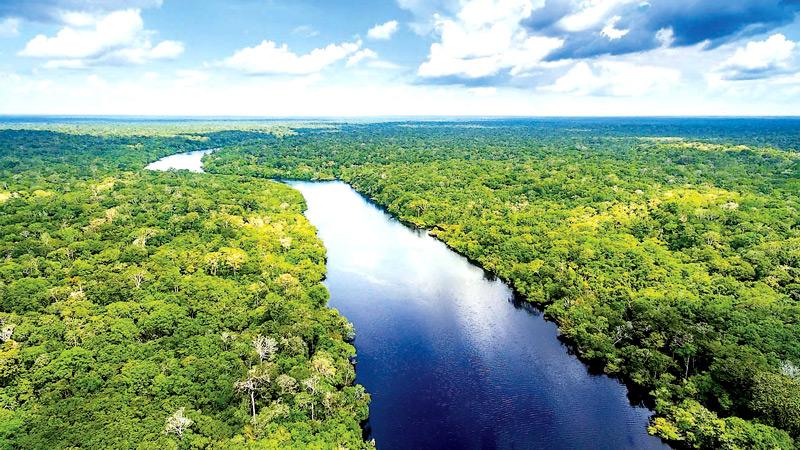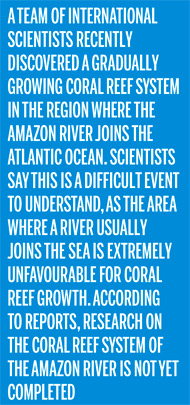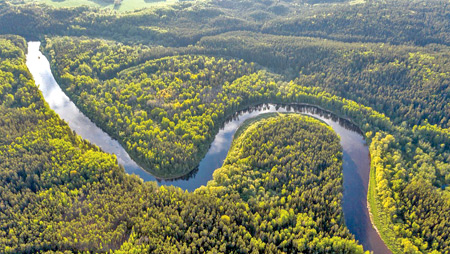
 It is no exaggeration to say that the Amazon River is the largest in the world in terms of volume as well as width, giving life to the Amazon rainforest in South America and making it the most important and complex ecosystem in the world. During the rainy season, the Amazon River and its basin, sometimes as wide as 48 kilometres (km) (30 miles) wide, provide shelter for many rare species of plants, and animals.
It is no exaggeration to say that the Amazon River is the largest in the world in terms of volume as well as width, giving life to the Amazon rainforest in South America and making it the most important and complex ecosystem in the world. During the rainy season, the Amazon River and its basin, sometimes as wide as 48 kilometres (km) (30 miles) wide, provide shelter for many rare species of plants, and animals.
 The 6,437-kilometre (4,000-mile) long voyage of the Amazon begins at the top of the Andes Mountains. The Amazon rainforest receives heavy rainfall throughout the year, nourishing the springs that supply water to the river due to the Andes Mountains, which retain the moist winds that blow from the east. The Amazon River flows for miles east through the woods and lowlands, eventually merging with the Atlantic Ocean off the northeastern coast of Brazil.
The 6,437-kilometre (4,000-mile) long voyage of the Amazon begins at the top of the Andes Mountains. The Amazon rainforest receives heavy rainfall throughout the year, nourishing the springs that supply water to the river due to the Andes Mountains, which retain the moist winds that blow from the east. The Amazon River flows for miles east through the woods and lowlands, eventually merging with the Atlantic Ocean off the northeastern coast of Brazil.
Shorter than the Nile
The Amazon is the second longest river in the world, slightly shorter than the Nile in Egypt. However, some scholars are of the opinion that the length of the Amazon River cannot be ascertained, as it has not yet been properly explored. The Amazon River, with over 1,100 tributaries (approximately 17 km long and approximately 1,500 km long), is without a doubt the largest natural drainage system in the world. It is estimated that the Amazon River accounts for about one-third of the total volume of water that flows over the earth’s surface.
Francisco de Oriana, a Spaniard, is credited with being the first European to explore the Amazon River in 1541. He is said to have named it the ‘Amazon River’ because the indigenous women warriors who fought against him during his explorations evoked his memory of the Amazons mentioned in Greek mythology.
The area around the Amazon River and its tributaries is known as the Amazon Basin. It covers 38 percent of the total land area of the South American Continent and covers an area of 6.9 million square kilometres (2.67 million square miles). Every year, the Amazon River and its tributaries overflow, nourishing the fertile Amazon Basin. Much of the Amazon Basin is covered by rainforests and is common to Brazil, Peru, Colombia, Ecuador, Bolivia, and Venezuela.
There are modern cities as well as tribal villages along the Amazon Basin, with an estimated indigenous population of 2.7 million. These indigenous people belong to about 350 tribes, and according to a Coordinator of Indigenous Organisations of the Amazon River Basin, more than 60 of these tribes are completely isolated from the modern world.
Largest freshwater dolphin
It is estimated that there are more than 5,600 species of fish in the Amazon River, including 100 species of electric fish and 60 species of piranhas. The Amazon River is home to the world’s largest freshwater fish, the Arapaima, which is about 4.6 metres (m) (15 ft) in size. The Amazon River is also home to the world’s largest freshwater dolphin species (which changes colour from gray to pink and then white as it ages). Giant seals and Amazon manatees is also found along the Amazon River.
A team of international scientists recently discovered a gradually growing coral reef system in the region where the Amazon River joins the Atlantic Ocean. Scientists say this is a difficult event to understand, as the area where a river usually joins the sea is extremely unfavourable for coral reef growth. According to reports, research on the coral reef system of the Amazon River is not yet completed.
No matter how advanced the technology of the modern world is everyone from scientists to rural people use the primary means of transport to cross the Amazon.
Accordingly, ferries and small ships are increasingly used to transport goods and people along the Amazon River, which is hidden in the rainforest.
Hijacking cargo
However, it is reported that pirates are now emerging along the Amazon River due to the increasing number of means of transportation without proper supervision to meet the needs of the growing Amazon population. Accordingly, it has been suggested that the risk of hijacking cargo as well as the smuggling of narcotics along the Amazon River may increase gradually.
